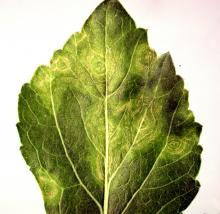See:
Greenhouse Plants, Ornamental - Impatiens Necrotic Spot
Cause The following viruses are a problem on dahlia and include tomato spotted wilt virus and impatiens necrotic spot virus, which have a thrips vector, dahlia mosaic virus (DMV), which has an aphid vector, and a tomato-ringspot-related virus which most likely has a nematode vector. DMV can be transmitted by 16 different aphid species (non-persistently), mechanical inoculation and through the seed. It was detected in cotyledons but rarely in the seed coat. Research in Washington has found 3 viruses associated with mosaic symptoms including dahlia mosaic virus (DMV), dahlia common mosaic virus (DCMV), and an endogenous plant pararetroviral sequence (DvEPRS).
Symptoms Dahlia mosaic produces distinct chlorosis along veins and may shorten the internodes, giving a stunted or bushy appearance in tolerant cultivars. A survey of commercial gardens, retail outlets, trial gardens and backyards around the USA found a wide range of symptoms in DMV infected plants that could not be correlated to cultivar. These symptoms included mosaic, chlorotic spots, general chlorosis of leaves, systemic chlorosis, deformation of newly emerging foliage and stunting.
The tomato-ringspot-related virus produces necrotic patches and marginal necrosis on the leaf blade.
Many plants may carry virus but show no symptoms at all.
Cultural control
- Select and plant only virus-tested (and found to be free of all known viruses) stock.
- Rogue out and destroy affected plants.
- Control insect (See the PNW Insect Management Handbook for details) or nematode vectors.
References Eid, S., Almeyda, C.V., Saar, D.E., Druffel, K.L., and Pappu, H.R. 2011. Genomic characterization of pararetroviral sequences in wild Dahlia spp. in natural habitats. Archives of virology 156:2079-2084.
Pahalawatta, V., Druffel, K., and Pappu, H.R. 2007. Seed transmission of Dahlia mosaic virus in Dahlia pinnata. Plant Disease 91:88-91.




